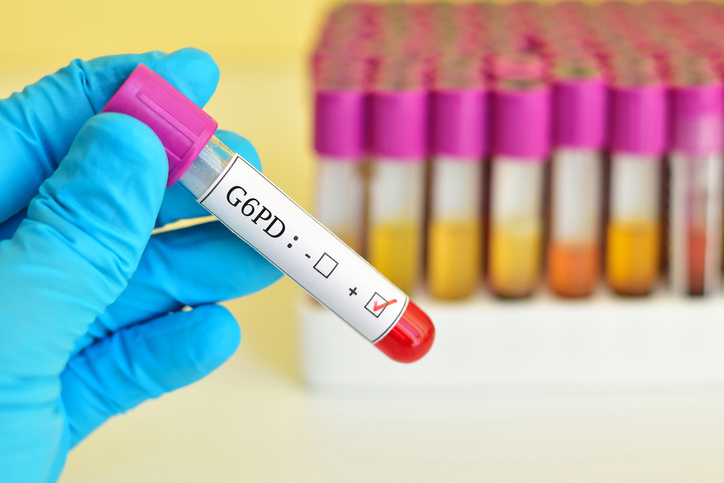Be Proactive About G6PD Deficiency- The Most Common Human Enzyme Defect

Less than a year ago, a mother in Sydney, Australia had to rush her five-year-old son to the hospital after he ate a “popular kids snack,” according to this news report.
The woman said her son turned yellow (a sign of jaundice) after eating three packs of fava beans. She also said that his urine was dark and that “he could barely wake up.”
It was a very scary incident, to say the least.
And it’s quite possible that if my husband ate fava beans, he too would have the same symptoms as this little boy.
Both my husband and this little boy have a genetic disorder that affects their body’s red blood cells, called G6PD deficiency.

“This reaction can also occur by just inhaling the pollen of the fava bean plant, known as favism. Low levels of G6PD is linked to favism, with factors like how many beans we've eaten; the severity of our G6PD deficiency; and other things related to our personal health and environment influencing the reaction,” according to one medical source.
“Compounds in fava beans, when digested, can boost the production of reactive oxygen species. This means there are even more threatening molecules in the body, and without G6PD enzyme, red blood cells sustain a lot of damage, which prompts hemolytic anemia.”
Interestingly, the mother of the little boy discussed said that another trigger for her son is moth balls.
There is a report of a three-year-old boy in Bangladesh “...who used to play with naphthalene moth-balls…”
(Naphthalene is a chemical commonly used as a moth repellent. It is also found in insecticides and toilet deodorant cakes).
Turns out, this little boy had G6PD deficiency and accidently ingested some of the mothball. He experienced symptoms of vomiting, abdominal pain, headache, fever, dark-colored urine and jaundice (all signs of hemolytic anemia).
If not treated properly, hemolytic anemia can damage your heart and other major organs.
The little boy in Bangladesh was treated with “... IV saline infusion, packed cell transfusion and oral antioxidant (Vit A, C, E) therapy.”
(To learn more about vitamin therapy, read here).
Certain medications may also trigger those who have a G6PD deficiency. There is an exhaustive list of the foods (and certain supplements) to avoid if you are deficient in G6PD. Some of these foods include breath mints, legumes, red wine, soy and certain pre-prepared Chinese foods. (You can read more about this here).
G6PD deficiency rarely occurs in women. Most cases are found in men.
“The disorder affects about 10 to 14 out of 100 African-American men in the U.S. It is also common in people from the Mediterranean area, Africa, or Asia,” according to Cedars-Sinai.
“The severity of the disorder varies, depending on the group. In African-Americans, the problem is mild. It mainly affects older red blood cells. In whites, the disorder is often more serious.”
According to the National Institutes of Health (NIH), there are four different classes (class 1, class 2, class 3 and class 4) of G6PD mutants. And basically, class 1 is the most intense and class 4 is the least severe.
“Most deficient subjects with class 2 variants are asymptomatic throughout their life unless oxidatively stressed.”
This is why many people do not know that they have this deficiency until they are triggered by a food, medication or chemical.
Although reports say G6PD deficiency led to 4,100 deaths in 2013 and 3,400 deaths in 1990, it does not appear that there have been any reported recent deaths.
How can we be proactive?
First, we cannot be proactive about things we do not know about. This is why testing is imperative. If you are a black or Indian male (for example), I strongly suggest getting tested. A simple blood test will usually disclose whether you are G6PD deficient.
(There is also a recent new device that can detect this condition in newborns).
If you discover that you are G6PD deficient, knowing what can trigger this condition is key. Speak with a competent healthcare professional about foods and medications you should avoid. For example, medications that may trigger an event include antimalarial drugs; Aspirin (high doses); nonsteroidal anti-inflammatory drugs (NSAIDs); Quinidine; sulfa drugs and certain antibiotics.
(“Classic food items include fava beans and other legumes, red wine (sulfites), tonic water (quinine), vitamin K, and menthol,” reports the NIH).
Administering high doses of vitamin C to people with G6PD deficiency may also be dangerous, which is why it is crucial to seek the advice of a doctor or competent healthcare professional about supplementation and vitamin IV therapy.
There is no known cure for G6PD deficiency, however, researchers at Stanford discovered a small molecule that may help treat this condition.
“The goal is to convert this molecule into a safe daily treatment for people with the enzyme deficiency.”
A daily treatment would be great, but getting tested and knowing the triggers are key. And finally, it is very important to work with your doctor to identify the nutrients that will help your body replace those red blood cells that may be prematurely destroyed, such as folic acid and iron (which you may have to get through supplementation).
Enjoy your healthy life!
The pH professional health care team includes recognized experts from a variety of health care and related disciplines, including physicians, attorneys, nutritionists, nurses and certified fitness instructors. This team also includes the members of the pH Medical Advisory Board, which constantly monitors all pH programs, products and services. To learn more about the pH Medical Advisory Board, clickhere.



